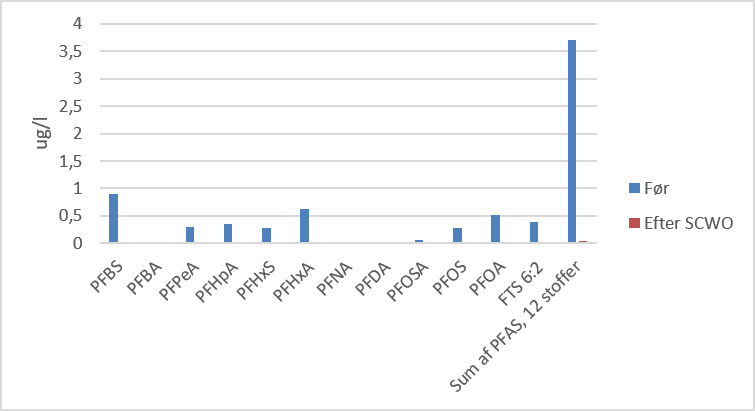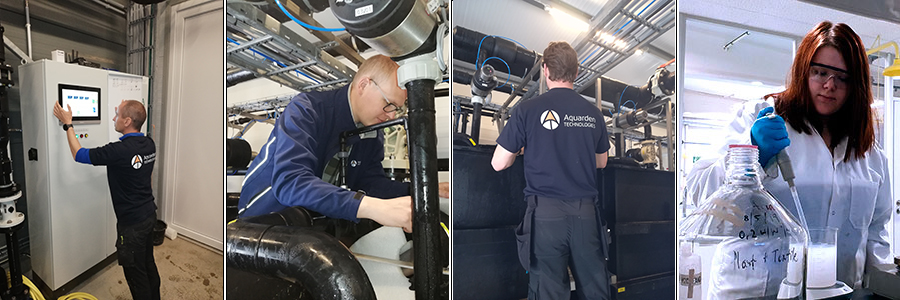Elimination of PFAS
SCWO technology eliminates 99,9% of PFAS from wastewater
Aquarden Technologies has developed a full-scale onsite solution to concentrate and destroy per- and polyfluoroalkyl substances (PFAS) from problematic wastewater with great success.
The PFAS group of chemicals includes substances such as perfluorooctane sulfonate (PFOS) and perfluorooctanoic acid (PFOA) that have been identified with growing concern as highly carcinogenic contaminants.
An initial study with leachate from Sörab waste deposit (SE) containing PFAS documented a successful removal of 19 PFAS components from the raw leachate.
After treatment in our SCWO reactor, all 19 PFAS substances including PFOS and PFOA were measured and found to be 99,9% eliminated. Results are shown in the figure below:

These compounds are extremely difficult to degrade even with advanced oxidation technologies but SCWO is able to completely destroy them.
PFAS
Widely spread
Large quantities of groundwater and soil are presently contaminated with PFAS that are found to be persistent, bioaccumulative and toxic. PFAS have been applied in many products and especially as flame retardants, and are extremely recalcitrant to conventional remediation technologies such as chemical and biological degradation. Therefore, the most common solution is to adsorb PFAS on activated carbon. The spent carbon typically needs to be transported great distances for treatment in special incineration plants that operate at extremely high temperatures for destroying the PFAS. This is a costly solution with a high carbon footprint.
Onsite treatment
Aquarden now offers an effective, onsite treatment of PFAS contaminated wastewaters with SCWO. Wastewater at high pressure and temperature is mixed with oxygen in the SCWO reactor, and results in a rapid and complete oxidation of all organic micro-pollutants, whereby pollutants are typically eliminated below their detection limits. Aquarden works with a variety of methods for capturing and concentrating PFAS from large volumes of contaminated water, depending on our customer’s requirements. For example, single-use adsorbents with a high affinity for PFAS can be used to capture PFAS from the wastewater, whereby the exhausted PFAS-rich adsorbent is fully destroyed in our SCWO reactor. Other PFAS-capture technologies we work with include membranes and foam fractionation.In addition, Aquarden has developed a process to wash PFAS off spent carbon and produce a PFAS-concentrate for treatment with SCWO, where the washed carbon can be reused for adsorption.
Aquarden essentially concentrates PFAS from the raw wastewater into a much smaller waste fraction, which in turn greatly lowers operational costs by many orders of magnitude during the PFAS destruction process with SCWO. After SCWO, no toxic byproducts are produced. The PFAS is completely broken down to water, nitrogen, and carbon dioxide, and is effectively eliminated from the environment.
Removal of PFAS from a Swedish airfield
Fire drills are conducted regularly on airfields, where fire extinguishing agents containing PFAS are used. As on many airfields, one airfield in Sweden has identified PFAS as a pollutant in their soil and water,and has therefore engaged Aquarden Technologies to remove these compounds.
In short, this is how we treated the PFAS-contaminated water:
- PFAS is adsorbed to activated carbon.
- Activated carbon is then “washed” with a methanol/ethanol solution to produce a PFAS-concentrate.
- The PFAS-concentrate is subsequently treated in the SCWO plant.
Both results can be seen in the scheme:
| PFOS ug/L | PFOA ug/L | |
| PFAS-concentrate from airfield | 679 | 34 |
| Water after SCWO treatment | <0.1 | <0.01 |


